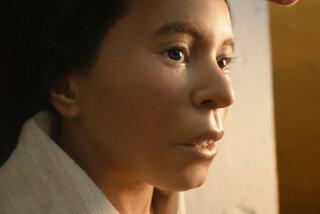Maya Woman’s Portrait a Rare Find
- Share via
An international team of archeologists has unearthed the earliest known portrait of a goddess or a royal Maya woman, a 6 1/2 -foot tall carved stone stele that is at least 200 years older than the earliest previously known portrait of a Maya queen.
The stele was damaged about AD 400 during an attack on the Maya city now known as Naachtun, in a remote section of northern Guatemala, then buried ceremonially amid the rubble as the city was rebuilt on top of it, said team leader Kathryn Reese-Taylor of the University of Calgary.
“That kind of [reburial] is done very infrequently,” she said, “usually because the king and the historic events on the monument were incredibly important to the history of the site. That makes us think this woman would have been really important to the people of Naachtun.”
That’s unusual, she added, “because there are prominent queens later, but not in this period. Usually, women are pictured in the background, as mothers and wives.”
The stele is also unusual in that it portrays only the woman’s head, in profile, in the middle of the stone. “When a historical figure is depicted, it is generally with a full body,” she said. “This is a portrait. There is not another like it in the Maya area.”
Glyphs in the figure’s headdress have been translated as the woman’s name: “Lady Completion Flower.”
After Reese-Taylor’s discovery was announced Monday, some proposed an alternative translation that suggested the figure was not feminine.
But a check of the literature showed that archeologist Simon Martin of the University of Pennsylvania had documented the same name on a stele from Tikal, dated nearly 200 years later, with the woman identified as the mother of a king. The name has also been found on a pair of looted earrings and on a stele fragment from Yaxha.
The names of royalty are frequently handed down from generation to generation among the Maya, so the woman on the stele may have been the namesake of the subsequent women of power or she might have been a deity they were named for.
“I’m pretty confident it will be a historical figure, an early queen,” Reese-Taylor said.
Archeologist Julia Guernsey of the University of Texas at Austin said the gender was significant. “It means that we may need to reevaluate the role and status of women within Early Classic Maya political dynamics,” she said.
Naachtun is about half a mile from the border with Mexico. The site was found in 1922 by Sylvanus Morley, who named it Naachtun, or “distant stone.” It was largely ignored until Reese-Taylor’s team began working there in 2004.
The city probably was founded around 400 BC, but it thrived during the Early Classic Maya Period, from AD 150 to 600. Some of its influence probably arose from its critical position halfway between Tikal and Calakmul, the two greatest cities of the Classic Maya world.
Those two cities formed powerful confederacies and fought wars with each other, both directly and through proxies. Naachtun was likely one of those proxies, and the partial destruction of the stele around AD 400 probably occurred during one of those wars, Reese-Taylor said.
The team has spent one season excavating the site. In addition to the stele with the woman on it, they have found 27 carved steles and at least 20 painted steles, most of them dating from the later period of city life.
More to Read
Sign up for Essential California
The most important California stories and recommendations in your inbox every morning.
You may occasionally receive promotional content from the Los Angeles Times.













